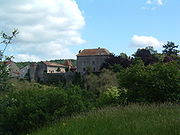
Château de Jaulny
Encyclopedia

Castle
A castle is a type of fortified structure built in Europe and the Middle East during the Middle Ages by European nobility. Scholars debate the scope of the word castle, but usually consider it to be the private fortified residence of a lord or noble...
in the commune
Communes of France
The commune is the lowest level of administrative division in the French Republic. French communes are roughly equivalent to incorporated municipalities or villages in the United States or Gemeinden in Germany...
of Jaulny
Jaulny
Jaulny is a commune in the Meurthe-et-Moselle department in north-eastern France.-Geography:The village lies in the middle of the commune, on the right bank of the Rupt de Mad, which flows northward through the commune.-See also:...
in the Meurthe-et-Moselle
Meurthe-et-Moselle
Meurthe-et-Moselle is a department in the Lorraine region of France, named after the Meurthe and Moselle rivers.- History :Meurthe-et-Moselle was created in 1871 at the end of the Franco-Prussian War from the parts of the former departments of Moselle and Meurthe which remained French...
département of France. It has been listed since 1966 as a monument historique
Monument historique
A monument historique is a National Heritage Site of France. It also refers to a state procedure in France by which national heritage protection is extended to a building or a specific part of a building, a collection of buildings, or gardens, bridges, and other structures, because of their...
by the French Ministry of Culture.
Military occupation of the site has been known since the 12th century. The fortified U-shaped house dates from the end of 15th or the beginning of the 16th century. An enclosing wall was built in second half of the 17th century. The site was transformed during the 18th century with a home built against the southern wall. Below the western wing are arched cellars dating from the 16th century. In spite of the successive alterations, the castle preserves the composition of the 16th century.
Joan of Arc?
Local tradition since the Middle AgesMiddle Ages
The Middle Ages is a periodization of European history from the 5th century to the 15th century. The Middle Ages follows the fall of the Western Roman Empire in 476 and precedes the Early Modern Era. It is the middle period of a three-period division of Western history: Classic, Medieval and Modern...
has it that Joan of Arc
Joan of Arc
Saint Joan of Arc, nicknamed "The Maid of Orléans" , is a national heroine of France and a Roman Catholic saint. A peasant girl born in eastern France who claimed divine guidance, she led the French army to several important victories during the Hundred Years' War, which paved the way for the...
, contrary to accepted wisdom, was not from Arc but that she was married to Robert des Armoises. Legend also has it that, far from being burned and her ashes being thrown into the Seine
Seine
The Seine is a -long river and an important commercial waterway within the Paris Basin in the north of France. It rises at Saint-Seine near Dijon in northeastern France in the Langres plateau, flowing through Paris and into the English Channel at Le Havre . It is navigable by ocean-going vessels...
, she is actually buried in Pulligny sur Madon. In 1871, two portraits were discovered when plaster was removed from a 15th century chimney. The village mayor confirmed that his great great grandfather had covered the portraits on the orders of Monsieur des Armoises before the French Revolution
French Revolution
The French Revolution , sometimes distinguished as the 'Great French Revolution' , was a period of radical social and political upheaval in France and Europe. The absolute monarchy that had ruled France for centuries collapsed in three years...
and that they were of Joan and her husband, Robert des Armoises. Several books have been published on this theory.

